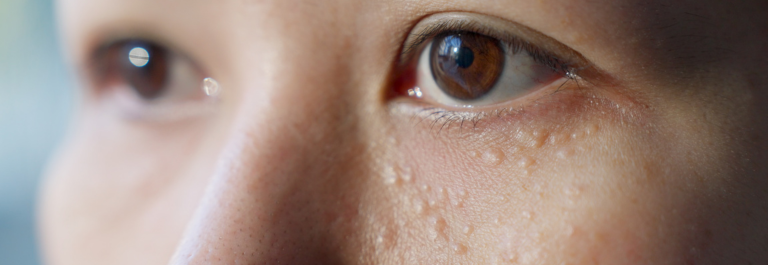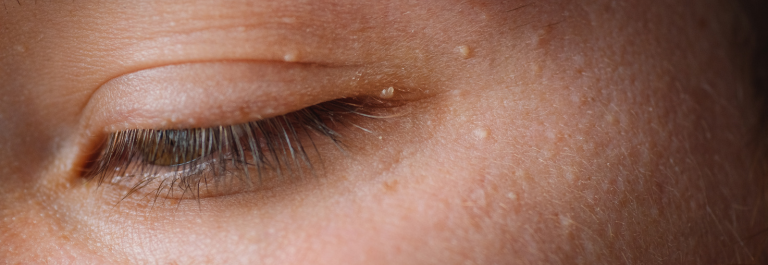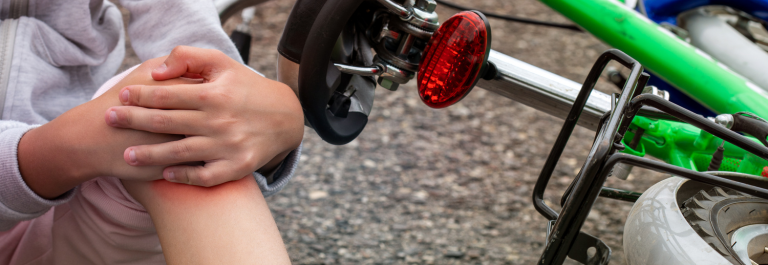Have you ever noticed small white or yellow bumps under your eyes and wondered what they were? These bumps are likely milia, a common skin condition affecting children and adults. While milia is entirely harmless, some people find that it is a cosmetic issue that makes them feel self-conscious. If this is you - don't fret! You can try many things to prevent or get rid of milia. In this article, we will discuss:
-
What is milia?
-
Causes of milia
-
Treatment of milia under the eyes
Read on to learn more about milia under the eyes and how to get rid of this skin condition naturally.
What Are Milia?
Milia - also called milk spots - are tiny white bumps on your skin, usually on the face and often under the eyes. They are very common in newborn babies but can affect children and adults, too. Neonatal milia typically go away in a few weeks, while milia in adulthood might last longer. Regardless of age, these little bumps tend to go away on their own.
People develop milia when dead skin cells collect to form tiny cysts under the skin's surface. These small cysts tend to be white, yellow, or skin-colored.
It can be easy to mistake milia for acne blemishes, but the causes for each issue are different. While pimples are caused by clogged pores, milia form under the skin's surface. Milia is not inflamed like acne, but they tend to stick around longer than pimples.
What Causes Milia?
There are two forms of milia: primary milia and secondary milia. Primary milia develop when keratin from dead skin cells builds up under the skin. Keratin is a protein in skin cells that provides structure and strength. An accumulation of dead skin means excess keratin is trapped under the skin's surface and becomes milia bumps.
Secondary milia are caused when damage to the skin (like a burn or abrasion) blocks the oil ducts underneath the skin.
Milia under your eyes can develop from several things, including:
-
Skin trauma
-
Reaction to a topical medication like corticosteroids
-
Occlusive skin products that prevent the skin's natural exfoliation
-
Sun exposure
-
Aging
-
Genetics
Prevent Milia Under the Eyes
Milia eye bumps are generally harmless but can be frustrating and are difficult to remove. The best way to get rid of milia is by preventing it from happening in the first place. Follow these tips as a part of a smart skincare routine to keep your undereye area free of milia.
Maintain a Natural Cleansing Regimen
Keeping your skin clean with a natural cleanser ensures that old skin cells don't have the chance to build up. This Coconut and Sunflower Oil Bar is a gentle cleanser with soothing ingredients like coconut oil, shea butter, and sunflower oil. It's safe to use even on the most delicate parts of the skin, like the undereye area, and will leave your face feeling clean, smooth, and refreshed.
Keep Your Facial Skin Moisturized
One of the reasons we may have too many keratin-containing skin cells on the surface of our skin is because our skin is dry. Too much dry skin means that your skin can't exfoliate fast enough, causing the build-up of keratin that leads to milia. Prevent milia by moisturizing your skin with a nourishing balm like this Organic Manuka Skin Soothing Cream, made from only six natural ingredients, including pure manuka honey. This cream has anti-microbial and anti-inflammatory properties, preventing milia from forming. For maximum effectiveness against milia, apply the cream as a face mask for 10 - 20 minutes. You'll get a gorgeous glow to boot!
Gently Exfoliate
One of the best preventative measures to treat milia is exfoliating the skin, which frees trapped keratin from the skin's surface. Gentle exfoliation with a warm facecloth protects the skin's delicate surface while getting rid of old skin.
Avoid Picking
Although it might be tempting, do not try to pick or pop milia. Since milia are underneath the skin's surface, they cannot be popped. Removing milia on your own can damage the skin and possibly lead to permanent scarring or infection.
How to Remove Milia
Milia tend to disappear on their own within a few weeks or months. But it's understandable if you're feeling frustrated by milia under your eyes. Many people find that milia can be a cosmetic issue that makes them feel self-conscious, and they opt to get treatment from a skin specialist.
Remember that the undereye area can be very sensitive and should be treated carefully. If you are concerned about stubborn milia, it's best to seek support from a dermatologist to find the proper treatment and prevent skin damage. Many professional treatments are available if you'd like to have a skin professional treat milia under your eyes.
Chemical Peels
Peels target recurring milia with chemical exfoliators like salicylic acid, glycolic acid, and lactic acid. A peeling agent will get rid of old layers of skin, revealing the new skin underneath.
Extraction
A dermatologist can remove milia under the eyes using a tiny needle to bring trapped keratin to the skin's surface.
Laser Ablation
The laser ablation method uses a tiny laser to open the pore and remove the debris caught within.
Cryotherapy
In cryotherapy, a doctor uses liquid nitrogen to freeze and destroy the milia. This can be particularly risky around the undereye area, so it is a less common way of dealing with milia on this area of the face.
Remove Milia Naturally
While having milia under the eyes can be frustrating and unsightly, rest assured that you are not alone. Follow these tips to remove your milia today!







